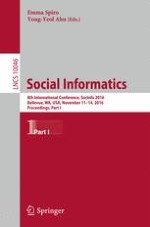2016 | Buch
Social Informatics
8th International Conference, SocInfo 2016, Bellevue, WA, USA, November 11-14, 2016, Proceedings, Part I
herausgegeben von: Emma Spiro, Yong-Yeol Ahn
Verlag: Springer International Publishing
Buchreihe : Lecture Notes in Computer Science
